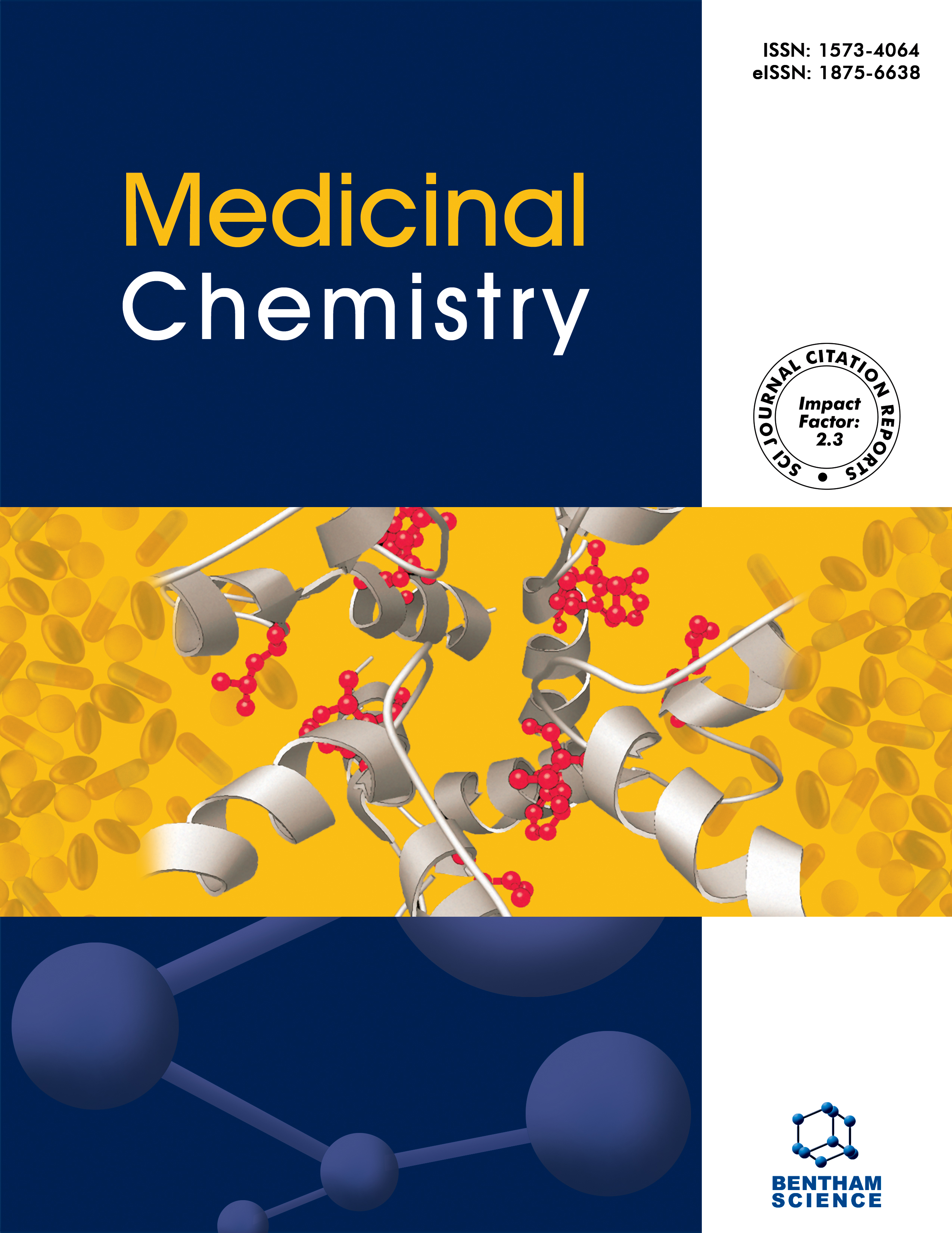- Home
- A-Z Publications
- Medicinal Chemistry
- Previous Issues
- Volume 15, Issue 7, 2019
Medicinal Chemistry - Volume 15, Issue 7, 2019
Volume 15, Issue 7, 2019
-
-
Novel Amide Derivatives as Potent Tyrosinase Inhibitors; In-vitro, In-vivo Antimelanogenic Activity and Computational Studies
More LessAuthors: Anser Ali, Zaman Ashraf, Muhammad Rafiq, Ajeet Kumar, Farukh Jabeen, Goon J. Lee, Fahad Nazir, Mushtaq Ahmed, Myungchull Rhee and Eun Ha ChoiBackground: Tyrosinase is involved in the melanin biosynthesis and the abnormal accumulation of melanin pigments leading to hyperpigmentation disorders. Controlling the melanogenesis could be an important strategy for treating abnormal pigmentation. Methods: In the present study, a series of amide derivatives (3a-e and 5a-e) were synthesized aiming to inhibit tyrosinase activity and melanin production. All derivatives Read More
-
-
-
Synthesis and Biological Evaluation of Acridine/Acridone Analogs as Potential Anticancer Agents
More LessBackground: The lack of efficacious therapy for advanced melanoma and neuroblastoma makes new approaches necessary. Therefore, many scientists seek new, more effective, more selective and less toxic anticancer drugs. Objective: We propose the synthesis of the new functionalized analogs of 1-nitroacridine/4- nitroacridone connected to tuftsin/retro-tuftsin derivatives as potential anticancer agents. Methods: Acridin Read More
-
-
-
Small Molecular Leads Differentially Active Against HER2 Positive and Triple Negative Breast Cancer Cell Lines
More LessAuthors: Adnan Badran, Atia-tul-Wahab, Sharmeen Fayyaz, Elias Baydoun and Muhammad I. ChoudharyBackground: Breast cancer is the most prevalent cancer type in women globally. It is characterized by distinct subtypes depending on different gene expression patterns. Oncogene HER2 is expressed on the surface of cell and is responsible for cell growth regulation. Increase in HER2 receptor protein due to gene amplification, results in aggressive growth, and high metastasis in cancer cells. Methods: The current study Read More
-
-
-
Design, Synthesis, and Biological Evaluation of Novel Thiazolyl Substituted Bis-pyrazole Oxime Derivatives with Potent Antitumor Activities by Selectively Inducing Apoptosis and ROS in Cancer Cells
More LessAuthors: Biao Xiong, Shi Chen, Peng Zhu, Meiling Huang, Weijie Gao, Rui Zhu, Jianqiang Qian, Yanfu Peng, Yanan Zhang, Hong Dai and Yong LingBackground: A large number of pyrazole derivatives have different biological activities such as anticancer, antimicrobial, anti-inflammatory, analgesic and antiepileptic activity. Among them, pyrazole oximes have attracted much attention due to their potential pharmacological activities, particularly anticancer activities. Objective: Our goal is to synthesize novel thiazolyl substituted bis-pyrazole oxime derivatives with poten Read More
-
-
-
Synthesis, Molecular Modelling and Biological Studies of 3-hydroxypyrane-4-one and 3-hydroxy-pyridine-4-one Derivatives as HIV-1 Integrase Inhibitors
More LessBackground: Despite the progress in the discovery of antiretroviral compounds for treating HIV-1 infection by targeting HIV integrase (IN), a promising and well-known drug target against HIV-1, there is a growing need to increase the armamentarium against HIV, for avoiding the drug resistance issue. Objective: To develop novel HIV-1 IN inhibitors, a series of 3-hydroxy-pyrane-4-one (HP) and 3- hydroxy-pyridine-4-one ( Read More
-
-
-
Synthesis and Biological Evaluation of Scutellarein Alkyl Derivatives as Preventing Neurodegenerative Agents with Improved Lipid Soluble Properties
More LessAuthors: He-Min Li, Ting Gu, Wen-Yu Wu, Shao-Peng Yu, Tian-Yuan Fan, Yue Zhong and Nian-Guang LiBackground: Exogenous antioxidants are considered as a promising therapeutic approach to treat neurodegenerative diseases since they could prevent and/or minimize the neuronal damage by oxidation. Objective: Three series of lipophilic compounds structurally based on scutellarein (2), which is one metabolite of scutellarin (1) in vivo, have been designed and synthesized. Methods: Their antioxidant activity was evaluated Read More
-
-
-
Helminthicidal and Larvicidal Potentials of Biogenic Silver Nanoparticles Synthesized from Medicinal Plant Momordica charantia
More LessBackground: The drug formulations used to control mosquito vectors and helminth infections have resulted in the development of resistance, and negative impact on non-target organisms and environment. Objective: Plant-mediated synthesis of silver nanoparticles (P-AgNPs) using aqueous fruit peel extract of M. charantia, applications of P-AgNPs for helminthicidal activity against Indian earthworms (P. posthuma) and larvici Read More
-
-
-
Evaluation of Antiplasmodial Potential of C2 and C8 Modified Quinolines: In Vitro and In Silico Study
More LessBackground: Malaria remains a common life-threatening infectious disease across the globe due to the development of resistance by Plasmodium parasite against most antimalarial drugs. The situation demands new and effective drug candidates against Plasmodium. Objectives: The objective of this study is to design, synthesize and test novel quinoline based molecules against the malaria parasite. Methods: C2 and C8 modifie Read More
-
-
-
Synthesis, Anti-Varicella-Zoster Virus and Anti-Cytomegalovirus Activity of 4,5-Disubstituted 1,2,3-(1H)-Triazoles
More LessBackground: Clinical drugs for herpesvirus exhibit high toxicity and suffer from significant drug resistance. The development of new, effective, and safe anti-herpesvirus agents with different mechanisms of action is greatly required. Objective: Novel inhibitors against herpesvirus with different mechanisms of action from that of clinical drugs. Methods: A series of novel 5-(benzylamino)-1H-1,2,3-triazole-4-carboxamides were effi Read More
-
-
-
Synthesis, Antimicrobial Evaluation and Molecular Docking of Some Potential 2,6-disubstituted 1H-Benzimidazoles; Non-Classical Antifolates
More LessAuthors: Sunil Harer, Manish Bhatia and Vikram KawadeBackground: Dihydrofolate reductase is one of the important enzymes for thymidylate and purine synthesis in micro-organisms. A large number of drugs have been designed to inhibit microbial DHFR but over the period of time, some drugs have developed resistance and cross reactivity towards the enzyme. Over the past few decades, benzimidazoles, triazoles and their derivatives have been grabbing the attention of the Read More
-
Volumes & issues
-
Volume 21 (2025)
-
Volume 20 (2024)
-
Volume 19 (2023)
-
Volume 18 (2022)
-
Volume 17 (2021)
-
Volume 16 (2020)
-
Volume 15 (2019)
-
Volume 14 (2018)
-
Volume 13 (2017)
-
Volume 12 (2016)
-
Volume 11 (2015)
-
Volume 10 (2014)
-
Volume 9 (2013)
-
Volume 8 (2012)
-
Volume 7 (2011)
-
Volume 6 (2010)
-
Volume 5 (2009)
-
Volume 4 (2008)
-
Volume 3 (2007)
-
Volume 2 (2006)
-
Volume 1 (2005)
Most Read This Month
Article
content/journals/mc
Journal
10
5
false
en


